Challenges Ahead for US Refiners?

Table of Contents
Author(s)
Tags
The U.S. refining industry has had a great run this century. But with the COVID-19 pandemic, 2020 was a tough year, resulting in the announcement of several domestic closures. Could the pandemic be a glimpse of things to come for U.S. refiners?
Between 2000 and 2019, U.S. refining capacity and throughput increased substantially (+2.4 and +1.5 million b/d, respectively), even though domestic oil consumption fell slightly (see Figure 1). Indeed, over that period, the U.S. moved from being one of the largest net importers of refined products in the world to being one of the largest net exporters.
- When U.S. overall oil import dependence peaked in 2005, the country had net refined product imports of about 2.4 Mb/d, more than Europe and Japan combined.
- But by 2019 (the last full year for which official data is available), the U.S. had become a net exporter of refined products, selling 3 Mb/d into global markets, just behind Russia (3.2 Mb/d) as the largest refined product net exporter.
Figure 1 — Net Refined Product Imports (Mb/d)
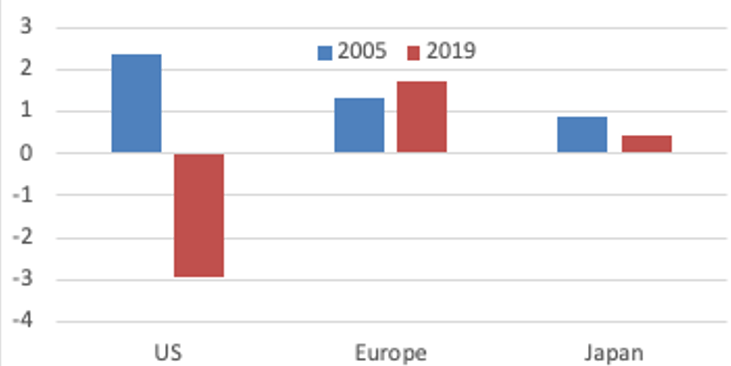
Moreover, the U.S. experience stands in sharp contrast to refiners in other industrialized countries (see Figure 2): Capacity and throughput in the EU each fell by 1.6 million b/d over the same period. Japanese refiners suffered even bigger declines in percentage terms.
Figure 2 — Refinery Indicators for the U.S. and EU (Mb/d)
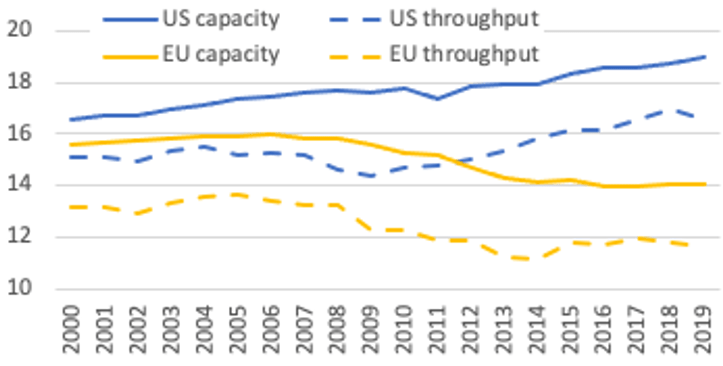
Source BP Statistical Review 2020
So What’s the Secret?
How have U.S. refiners competed so successfully? Technical excellence, shale (with help from Canadian producers) … and an unintentional boost from policy.
First is technical excellence. U.S. refiners are highly sophisticated … and have the benefit of operating in the world’s largest oil-consuming nation. Simply put, they are able to produce lots of highly marketable gasoline and diesel fuel, with few of the less-valuable byproducts. In technical terms, the U.S. refinery fleet has much more upgrading capacity, enabling it to turn surplus residual fuel oil (an output of the basic refinery distillation process) into more marketable fuels. One measure of refinery complexity is the Nelson complexity index: It shows that North American (largely U.S.) refiners on average are significantly more complex than their competitors in Europe and Asia, with scores of 11.6, 9.3, and 9.8 respectively (source: ENI World Oil Review 2020, p73). As a result of their greater complexity, U.S. refineries produce almost all gasoline, diesel and jet fuel (86% of U.S. output, or “yields”, in 2019), while globally these fuels account for barely 60% of demand. And U.S. refiners produce and almost no (1%) residual fuel oil, whereas globally this less-valuable product constitutes 7% of demand (largely sold at large discounts for use in shipping and power generation).
In addition, U.S. refiners are highly adaptive to changing market circumstances. As a group, they are able to shift both the crudes used in their operations and the products they produce. For example, U.S. refineries accustomed to processing heavier, medium grades found they could produce a synthetic medium crude by blending cheap North American heavy and light crudes. A number of refiners also invested in new refinery configurations to take advantage of discounted North American crudes.
But technical sophistication wasn’t enough on its own. Remember: even with sophisticated domestic refineries, the U.S. was a net importer of refined products in 2000 (and through 2010).
The next boost for U.S. refiners was the boom in North American oil production. As everyone knows, this was largely due to the U.S. shale boom, with a helping hand from our neighbors to the North. U.S. crude oil production boomed this century, growing by roughly 6.5 Mb/d from 2000-2019. That was almost as much as the growth from Russia and Saudi Arabia combined, and allowed the U.S. to surpass those countries to become the world’s largest producer. In addition, Canadian production increased by 2.5 Mb/d — a growth increment behind only the "big three."
Booming North American crude oil supply was a boon for U.S. refiners …especially when runaway production growth out-stripped pipeline capacity. Differentials for North American crudes — normally a function of the quality of the crude oil and pipeline/tanker rates — widened dramatically, as oil producers were forced to discount their crudes so they could be economically shipped on more expensive modes: rail and truck. Access to distressed crude oil in turn allowed many domestic refiners to produce gasoline, diesel and other refined products well beyond domestic requirements, and to profitably sell their surplus refined product into global markets.
- The shale boom also benefitted U.S. refiners by giving them access to some of the cheapest natural gas in the world, used in refineries as a source of heat and power as well as a feedstock.
And this leads to the inadvertent boost from policy, which contributed to the North American bottlenecks. In the U.S., the longstanding ban on crude oil exports made soaring supply captive to the domestic market. But even after the crude export ban was lifted at the end of 2015, slow permitting in both the U.S. and Canada combined with record production growth to leave pipeline and export capacity constrained for crude oil for much of the time.
These factors boosted U.S. refining profitability, both in absolute terms and relative to other refining centers. Before the North American crude production boom, U.S. margins were broadly similar to those in Europe and Asia (with a small benefit from their greater complexity); since 2005 U.S. margins have increased significantly, as has their advantage relative to other regions (see Figure 3).
Figure 3 — Refining Margins ($/bbl)
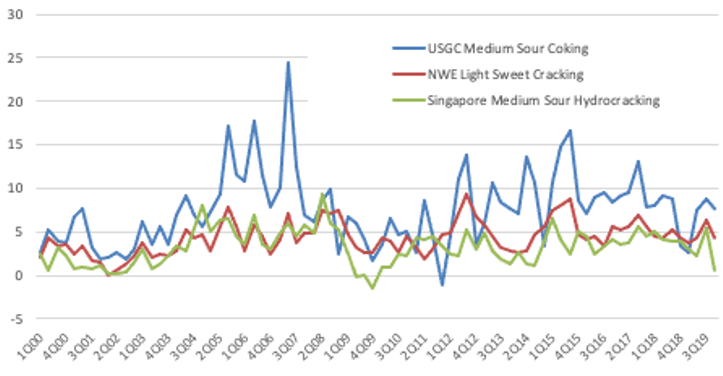
2020: End of the Good Times?
Was the pain of a global pandemic a window into the future for U.S. refiners? Last year, not only did domestic demand collapse … so did domestic (and Canadian) supply. And without rapid growth of supply creating transport bottlenecks, North American producers did not need to aggressively discount their crudes. For example, the differential between the main U.S. and European crude benchmarks narrowed dramatically once the pandemic struck (see Figure 4).
- With growing trade of liquefied natural gas, U.S. and global natural gas prices have also converged, further reducing the U.S. competitive advantage.
Figure 4 — Crude Oil Prices ($/bbl)
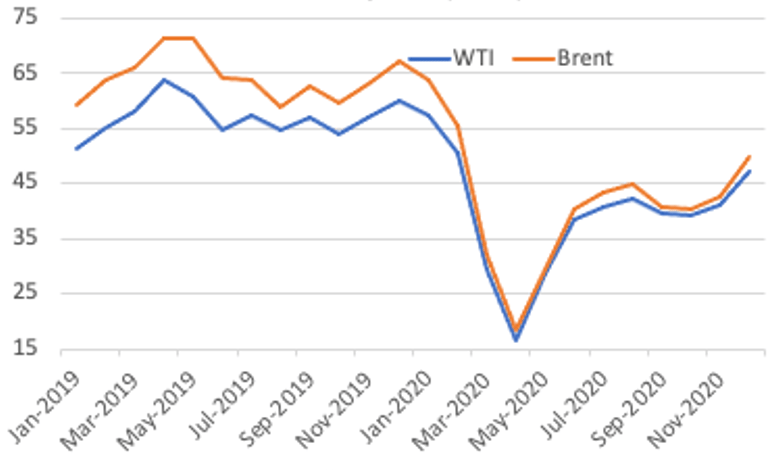
And with less competitively priced crude oil inputs and falling demand globally, (gross) U.S. exports of gasoline, diesel and jet fuel all declined in 2020 (see Figure 5). (Net exports declined for diesel and jet fuel. On the other hand, gasoline — for which the U.S. is a net importer — saw net imports fall along with domestic demand.) Indeed, in the depths of the pandemic-related downturn, the U.S. briefly returned to being a net oil importer in May and June, though it has returned to net exporter status as domestic production has recovered.
Figure 5 — U.S. Refined Product Exports (Year-on-year Change, Kb/d)
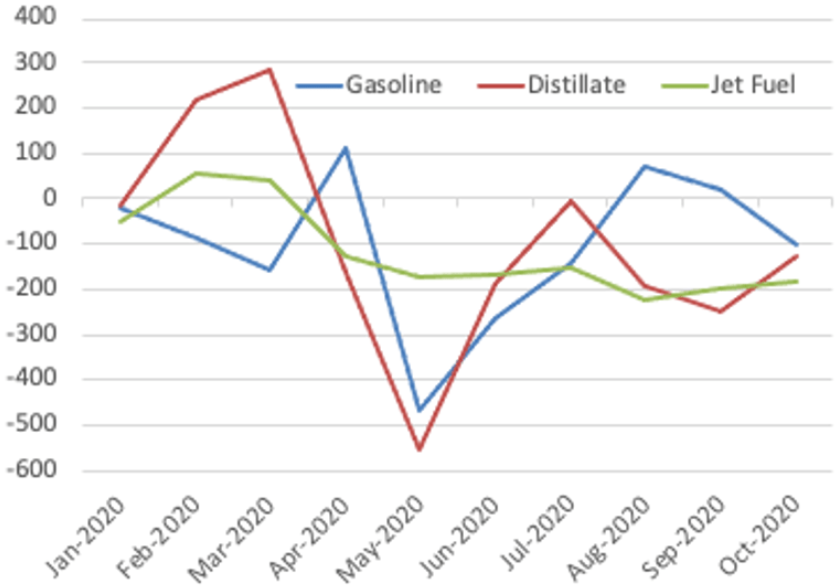
The bad news had an impact. After being shielded for most of this century from the challenges faced by competitors in Europe, Japan and elsewhere, some U.S. refiners had to face the music in 2020. Announced plans to close refineries include several in California, as well as Louisiana, New Jersey, Pennsylvania, and Wyoming. The U.S. Energy Information Administration reports that operable U.S. refining capacity fell by about 600,000 b/d in 2020.
Further complicating the picture for U.S. refiners, new sophisticated refineries continue to open — both in countries with growing demand, like China and India, as well as in major oil producing countries in the Middle East. Indeed, China is likely to replace the U.S. as the world’s largest refining center this year. Like many U.S. refineries, these new refineries have significant upgrading capacity, and are competitively sited near dynamic demand or supply centers — and many of them are shielded from global competition by their home governments.
What does this tell us about the future?
Most analysts expect U.S. and Canadian crude oil production to be broadly flat in coming years due to a cautious oil market outlook and concern among investors that producers have not returned sufficient cash to investors. The likelihood of new policies to limit development of federal lands, and of stricter regulation (for example, of methane emissions), will raise further challenges for domestic producers. Slow (or no) growth in North American crude supply means that bottlenecks will disappear (unless existing pipelines come under regulatory threat). At the same time, policies aimed at boosting the use of electric vehicles threatens future U.S. (and global) oil demand.
- Moreover, U.S. refineries themselves are likely to face a more challenging policy environment as emissions of CO2 and other volatile organic compounds face tougher regulation.
While many U.S. refineries will retain their world class technical excellence, a shrinking domestic market, less access to distressed/bottlenecked crude oil production, and growing competition from new sophisticated refiners elsewhere all mean that U.S. refiners are likely to look back on 2019 as the end of the good old days.
This post originally appeared in the Forbes blog on February 2, 2021.



